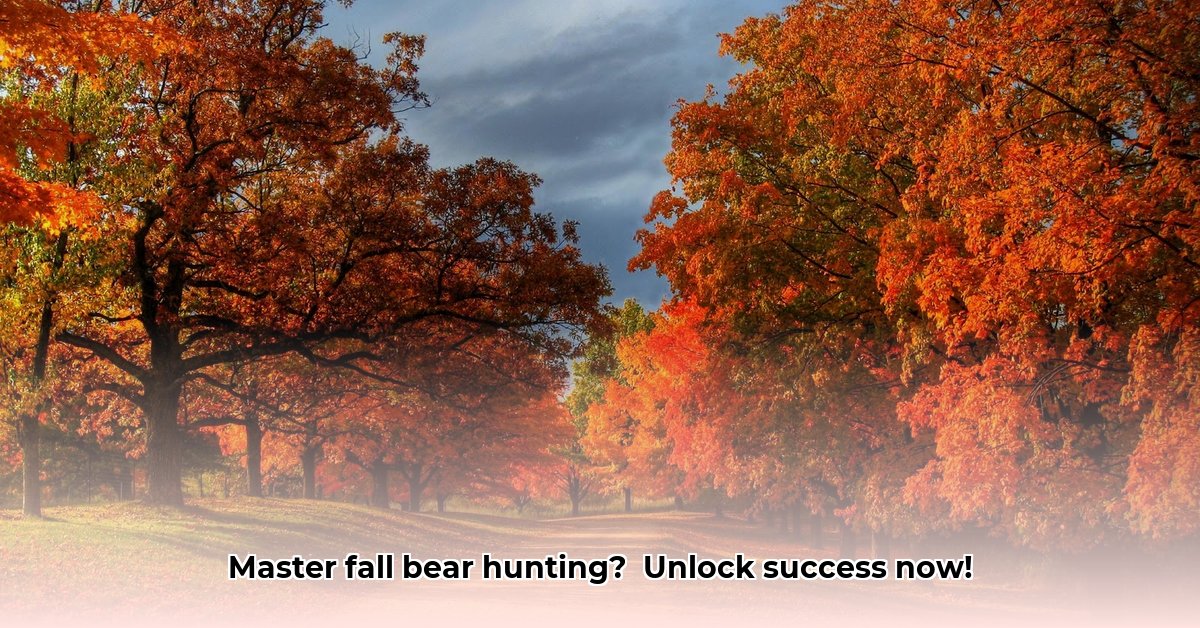Fall is a prime time for black bear hunting. As they prepare for winter hibernation, bears are more active and focused on consuming high-calorie foods, making them easier to locate with the right strategies. This instructional guide offers comprehensive insights, covering everything from understanding bear behavior and scouting techniques to selecting appropriate gear and ensuring safety, to improve the chances of a safe and ethical hunt. Whether you are a beginner or a seasoned hunter, mastering fall bear hunting requires a blend of knowledge, preparation, and respect for wildlife. Let’s explore the key elements for a successful autumn hunt in the woods, focusing on proven strategies and actionable steps for bear obsession.
Fall Bear Hunting: Your Guide to a Successful Season
Preparing for a fall bear hunt demands a strategic approach distinct from other hunting expeditions. Black bears possess unique characteristics and require specialized knowledge. This section outlines how to maximize your chances of a safe and successful hunt, emphasizing respect for the animal and strict adherence to safety protocols. Understanding the fall bear, the impact of bait, and the appropriate gear are great places to start when mastering safe bear hunting.
Understanding Fall Bear Behavior: Fueling Up for Winter
In the fall, a bear’s primary focus is on gaining weight for the upcoming winter hibernation. This period, known as hyperphagia, drives bears to consume as many calories as possible. Understanding this behavior is the foundation of successful fall bear hunting.
- Hyperphagia: Driven by an instinctive need to store fat for hibernation, bears enter a state of intense feeding. This drives them to seek out areas with abundant food sources.
- Daily Patterns: While spring bears tend to be more active during daylight hours, fall bears often adjust their schedules to maximize feeding opportunities, particularly during dawn and dusk. However, they might also forage throughout the day if food availability is high and human activity is low.
- Territoriality: As food becomes scarcer, bears may become more territorial, leading to increased competition and potential conflicts.
- Den Selection: Late in the fall, bears begin searching for suitable denning sites, typically in sheltered areas like caves, hollow logs, or under root systems.
Scouting for Fall Bears: Finding the Feast
Locating bears before the hunt is crucial. Focus on identifying prime feeding areas where bears congregate to consume high-calorie foods in preparation for winter. Think like a hungry bear readying for hibernation.
- Identify High-Calorie Food Sources: Focus on areas abundant with ripe berries such as blackberry patches, oak forests loaded with acorns, apple orchards (if accessible), and locations teeming with insects (a protein source for bears). Also look for the presence of nut-bearing trees like hickory or walnut. Additionally, water sources are essential as bears need to hydrate, especially after consuming large amounts of dry food.
- Utilize Trail Cameras: Strategically position trail cameras near feeding areas, water holes, and trails to monitor bear activity. Consider using cameras with infrared flash or no-glow technology to avoid spooking bears. Check the cameras regularly to identify active times of day. Dawn and dusk are typically peak activity periods, though some bears may be more active at night or midday. Note the frequency of bear visits to specific locations.
- Observe Trails and Patterns: Analyze the trails bears use to understand their travel patterns and preferred routes. Look for tracks, scat, and claw marks on trees. This information provides insights into where they are likely to be found. Pay attention to the direction of travel and the size of the tracks to estimate the size of the bears using the trails.
- Look for Bear Sign: Besides trails, actively look for bear sign. Overturned rocks and logs indicate bears searching for insects. Scat analysis can reveal what the bears have been eating in the area. Scratches on trees, especially those with smooth bark, are often used for marking territory.
Gear Up for Success: What You Need in the Woods
Having the right equipment is essential for both safety and success. Here’s a breakdown of the necessary gear:
- Reliable Rifle/Bow: Select a caliber or draw weight suitable for bear hunting, consulting experienced hunters or adhering to hunting regulations. For rifles, popular choices include .30-06, .308, and .300 Win Mag. For bows, ensure sufficient kinetic energy for a clean kill. Extensive practice at various ranges is crucial for ensuring accuracy and confidence.
- Ammunition/Arrows: Use high-quality ammunition or arrows designed for large game hunting. For rifles, consider bullets with controlled expansion for deep penetration. For bows, use broadheads with a reputation for sharpness and durability.
- Dependable Optics: A high-quality spotting scope with good magnification is necessary for spotting bears from a distance, enhancing safety and hunting success. Binoculars are also useful for closer observations. Consider binoculars with a wide field of view for scanning large areas.
- Rangefinder: A laser rangefinder assists in accurately determining the distance to the target, crucial for ethical shot placement.
- Effective Camouflage: Choose quality camouflage clothing that matches the hunting terrain to minimize visibility and blend into the environment. Consider a camouflage pattern that is effective in both wooded and open areas.
- Scent Control: Use scent-reducing soaps, sprays, and clothing to minimize human odor, which can alert bears to your presence.
- Bear Spray: Bear spray is mandatory. Familiarize with its operation and practice deploying it before encountering a bear. Store it in an easily accessible location.
- First-Aid Kit: Pack a comprehensive first-aid kit designed for wilderness situations, including items for potential bear encounters. Include supplies for treating cuts, burns, sprains, and allergic reactions.
- Communication Device: A satellite phone or personal locator beacon (PLB) can be critical for emergencies in areas with limited cell service.
- Navigation Tools: Include a GPS device, compass, and topographic map for navigating in unfamiliar terrain. Learn how to use them effectively.
- Knife: A sharp, durable knife is essential for field dressing and other tasks.
- Game Bags: Bring game bags to protect the meat from insects and contamination after harvesting a bear.
- Headlamp/Flashlight: A reliable light source is necessary for navigating in the dark.
- Water and Food: Carry sufficient water and non-perishable food for the duration of your hunt.
- Other Essentials: Include appropriate clothing for varying weather conditions, sturdy boots, a knife, extra ammunition, and sufficient water and food.
Hunting Strategies: Different Approaches for Different Hunters
Various hunting methods can be effective. Each requires its own set of skills and experience:
- Spot-and-Stalk: Involves moving through bear habitat using optics to locate bears. Success depends on stealth, knowledge of bear behavior, and keen observation.
- Glassing Techniques: Spend significant time glassing from high vantage points, focusing on areas with potential food sources.
- Wind Awareness: Pay close attention to wind direction, as bears have an excellent sense of smell. Approach bears from downwind whenever possible.
- Silent Movement: Move slowly and deliberately, minimizing noise. Use natural cover to conceal your movements.
- Baiting (where legal): Requires careful bait placement, adherence to regulations, and monitoring of bait sites. Improper baiting can attract unwanted animals.
- Bait Selection: Use a variety of baits that are appealing to bears, such as sweets, meats, and grains.
- Bait Site Management: Regularly replenish bait and monitor the site with trail cameras.
- Stand Placement: Position your stand or blind in a location that provides a clear shot at the bait site while considering wind direction.
- Hound Hunting (where legal): Requires well-trained dogs, communication skills, and knowledge of bear behavior and hunting regulations.
- Dog Handling: Work with experienced houndsmen who know how to manage and control their dogs.
- Communication: Maintain constant communication with other hunters and dog handlers.
- Safety: Be aware of the potential dangers of hunting with hounds, such as rough terrain and close encounters with bears.
- Still Hunting: Moving slowly and deliberately through the woods, pausing frequently to observe and listen.
- Focus on Sign: Pay attention to tracks, scat, and other signs of bear activity.
- Listen Carefully: Listen for sounds that indicate the presence of bears, such as breaking branches or vocalizations.
- Use Cover: Use natural cover to conceal your movements.
Safety First: Respecting the Wild
Bear hunting is inherently dangerous. Follow these safety measures to minimize risks:
- Bear Spray is Essential: Carry bear spray at all times and know how to use it effectively. Practice deploying it in a safe environment.
- Firearm Safety: Handle firearms responsibly and follow all safety rules.
- Avoid Close Encounters: Never approach bears, especially those with cubs, and observe them from a safe distance.
- Make Noise: When hiking in bear country, make noise to avoid surprising bears.
- Travel with a Partner: Hunting with a partner is safer.
- Inform Others of Your Plans: Always tell someone where hunting, your planned route, and expected return time.
- Be Aware of Your Surroundings: Pay attention to the terrain, weather conditions, and signs of bear activity.
Navigating the Legal Landscape: Knowing the Rules
Every state and hunting zone has specific regulations for bear hunting
- Bulking Lunch Recipes that Make Muscle Gain Delicious - November 12, 2025
- Simple Asian Meal Prep Recipes to Spice Up Your Week - November 11, 2025
- Simple Asian Meal Prep Ideas For Healthy And Flavorful Weekday Meals - November 10, 2025










